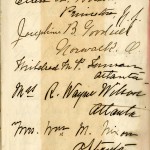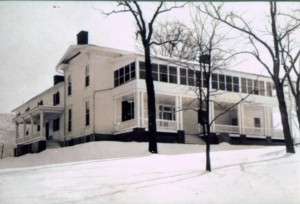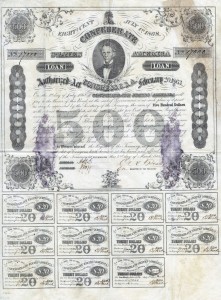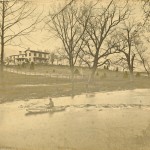Rosendale is associated with three Presidents, Woodrow Wilson (1913-1921), Warren G. Harding (1921-1923), and Franklin Delano Roosevelt (1933-1945).
Among the documents and artifacts found during the restoration of Rosendale was the original Guestbook bearing the signature of Ellen Oxson Wilson, first wife of Woodrow Wilson and the future First Lady of the United States, for a February 6, 1908 dinner in her honor.
 A copy, along with the newspaper article which accompanied the Guestbook, is on display in the Museum Room.
A copy, along with the newspaper article which accompanied the Guestbook, is on display in the Museum Room.
The Wilsons were life long friends with the family which bought Rosendale from the original owners of the property, the Rosenberger family, in 1920.
The three daughters of Woodrow and Ellen, Jessi (Mrs. Francis B. Sayre), Eleanor (Mrs. W.G. McAdoo) and Miss Margaret Woodrow Wilson, along with President Wilson’s second wife Edith Bolling Galt Wilson, attended a lavish luncheon at Rosendale for President Franklin Delano Roosevelt on April 22, 1939.
FDR’s “Guest List” is also on display in the Museum Room, as is a President Harding invitation to dinner at The White House on January 26, 1922.
 Evolution of the Rosendale “Mansion”
Evolution of the Rosendale “Mansion”
There is an 1870s photo of the Rosendale “mansion” and Smith Creek below showing a man in a canoe with the name “Rosendale” on it on display in the Museum Room.
We don’t know the exact year the name “Rosendale” came into being, but it was sometime between 1800 and 1825. Originally 3000 acres, by 1850 the 500 acre Rosenberger property was called the “Rosendale plantation.”
 Family tradition has it that the original two story log structure (now the dining room and James Madison suite) was built by George Rosenberger circa 1790. His son George W., who became famous in the mid 1850s for importing “fine breeds of stock,” was born at Rosendale in 1823 and inherited the house in 1858. While the huge barn at Rosendale was burned by Union soldiers during the Civil War, the house was spared because George W. was a “Northern sympathizer.” According to documents in the Rosenberger family archives kept at the Virginia Military Institute, George W. hired a substitute to take his place fighting for the Confederacy.
Family tradition has it that the original two story log structure (now the dining room and James Madison suite) was built by George Rosenberger circa 1790. His son George W., who became famous in the mid 1850s for importing “fine breeds of stock,” was born at Rosendale in 1823 and inherited the house in 1858. While the huge barn at Rosendale was burned by Union soldiers during the Civil War, the house was spared because George W. was a “Northern sympathizer.” According to documents in the Rosenberger family archives kept at the Virginia Military Institute, George W. hired a substitute to take his place fighting for the Confederacy.
 In 1870, Mr. Rosenberger more than doubled the size of the original structure, turning the “two over two” log cabin into the east wing of a beautiful new Anti-Bellum “mansion.” A kitchen and a bedroom above (now the Andrew Jackson suite) were added onto the east end of the log house and a 40 ft. two story porch was built on the south side. New north and south wings consisting of four rooms (now the Museum room, Franklin Delano Roosevelt, Woodrow Wilson suites, and the owner’s “Master suite”), separated by a stair hall, were added onto the west side of the log cabin. A grand west main entrance facing Smith Creek was built, as was a single story front porch.
In 1870, Mr. Rosenberger more than doubled the size of the original structure, turning the “two over two” log cabin into the east wing of a beautiful new Anti-Bellum “mansion.” A kitchen and a bedroom above (now the Andrew Jackson suite) were added onto the east end of the log house and a 40 ft. two story porch was built on the south side. New north and south wings consisting of four rooms (now the Museum room, Franklin Delano Roosevelt, Woodrow Wilson suites, and the owner’s “Master suite”), separated by a stair hall, were added onto the west side of the log cabin. A grand west main entrance facing Smith Creek was built, as was a single story front porch.
After Colonel E.T. Brown, the owner of Endless Caverns, purchased the house and the 356 acre Rosendale farm adjoining his Endless Caverns property, he “anticipated making extensive changes and improvements” (Valley, January 30, 1920), and he did. Brown added a two story addition to the south side of the 1870 addition. He also removed the 1870 front porch and built a new two story porch further out from the house. In 1928-30, a single story porch on the north side of the 1870 addition was enclosed which is now the library.
 Rosendale is described in many historical documents as “The frequent scene of much lavish hospitality.” A November 9, 1902 obituary of George W. Rosenberger reads that the “old home was one of the most beautiful in its section and was well suited to entertaining in true Virginia style.”
Rosendale is described in many historical documents as “The frequent scene of much lavish hospitality.” A November 9, 1902 obituary of George W. Rosenberger reads that the “old home was one of the most beautiful in its section and was well suited to entertaining in true Virginia style.”
A second obituary confirms that “Rosendale was known far and wide, where mirth, music, good cheer and pleasure did much abound.”
“Especially did he take great pride in his home, where warm hospitality was dispensed with a hearty welcome,” a third obituary reads.
According to the 1937 book Historic Homes of Northern Virginia, “The Browns have kept up the ‘Rosendale’ tradition.”
A complete list entitled “Among the Guests of Edward and Esther Brown at The Farmhouse, Endless Caverns, New Market, Virginia, May 1932-January 1961”compiled by Esther Brown is on display in the Museum Room.
More on Rosendale’s history, including a binder book and studies done by the James Madison University’s Department of History and Preservation can be found in the Museum Room.

